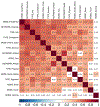No strong evidence that social network index is associated with gray matter volume from a data-driven investigation
- PMID: 32113045
- PMCID: PMC7774327
- DOI: 10.1016/j.cortex.2020.01.021
No strong evidence that social network index is associated with gray matter volume from a data-driven investigation
Abstract
Recent studies in adult humans have reported correlations between individual differences in people's Social Network Index (SNI) and gray matter volume (GMV) across multiple regions of the brain. However, the cortical and subcortical loci identified are inconsistent across studies. These discrepancies might arise because different regions of interest were hypothesized and tested in different studies without controlling for multiple comparisons, and/or from insufficiently large sample sizes to fully protect against statistically unreliable findings. Here we took a data-driven approach in a pre-registered study to comprehensively investigate the relationship between SNI and GMV in every cortical and subcortical region, using three predictive modeling frameworks. We also included psychological predictors such as cognitive and emotional intelligence, personality, and mood. In a sample of healthy adults (n = 92), neither multivariate frameworks (e.g., ridge regression with cross-validation) nor univariate frameworks (e.g., univariate linear regression with cross-validation) showed a significant association between SNI and any GMV or psychological feature after multiple comparison corrections (all R-squared values ≤ .1). These results emphasize the importance of large sample sizes and hypothesis-driven studies to derive statistically reliable conclusions, and suggest that future meta-analyses will be needed to more accurately estimate the true effect sizes in this field.
Keywords: Cross-validation; Gray matter volume; Predictive modeling; Social network index.
Copyright © 2020 Elsevier Ltd. All rights reserved.
Figures






References
-
- Asendorpf JB, & Wilpers S (1998). Personality effects on social relationships. Journal of Personality and Social Psychology, 74(6), 1531–1544. 10.1037/0022-3514.74.6.1531 - DOI
-
- Barton RA (1999). The evolutionary ecology of the primate brain In Comparative primate socioecology (pp. 167–194).
-
- Beck AT, Steer RA, & Brown GK (1996). Manual for the beck depression inventory-II. San Antonio, TX: Psychological Corporation.
Publication types
MeSH terms
Grants and funding
LinkOut - more resources
Full Text Sources
Medical

